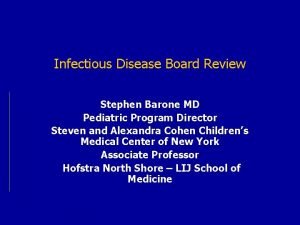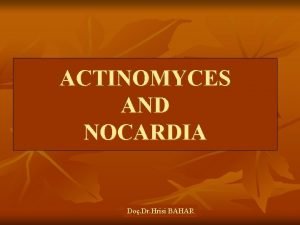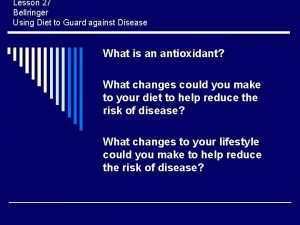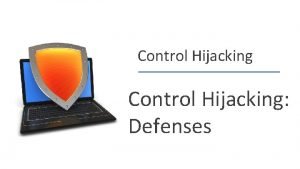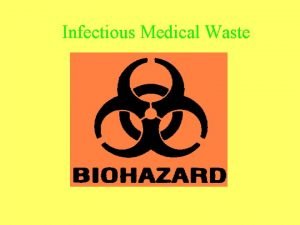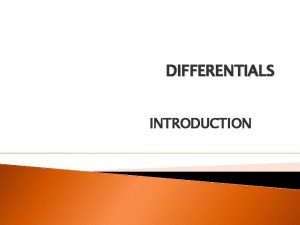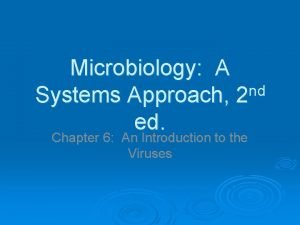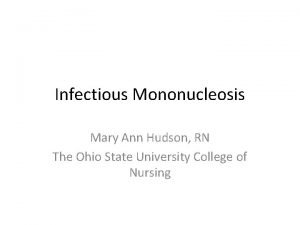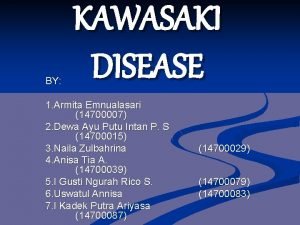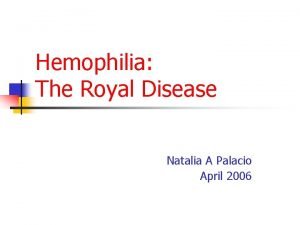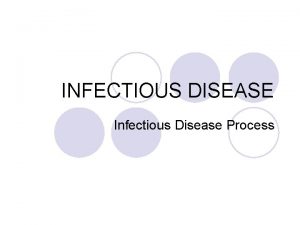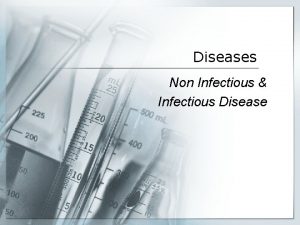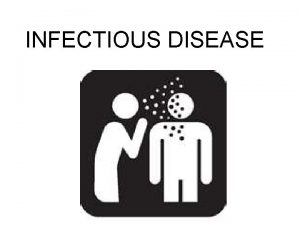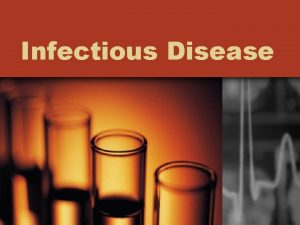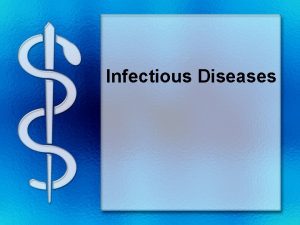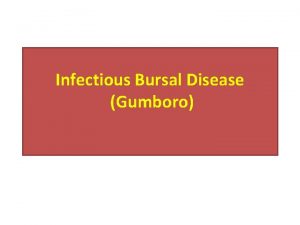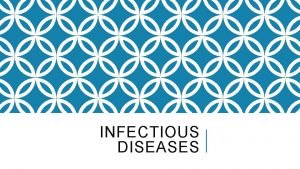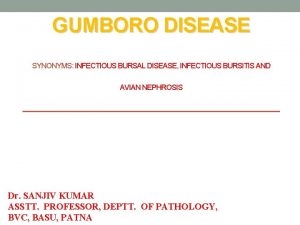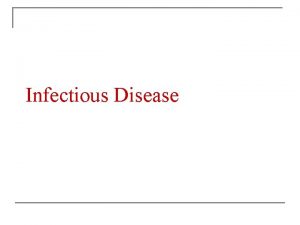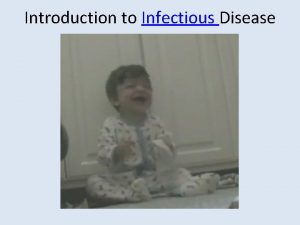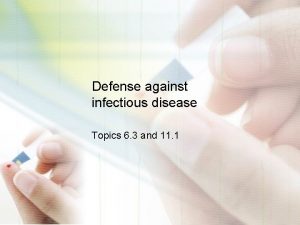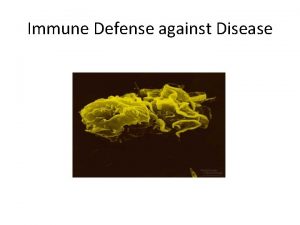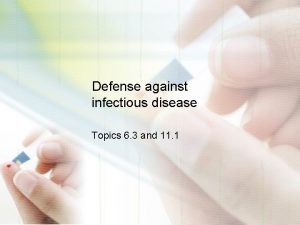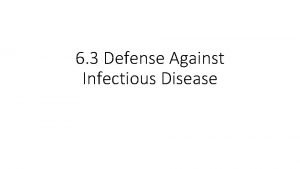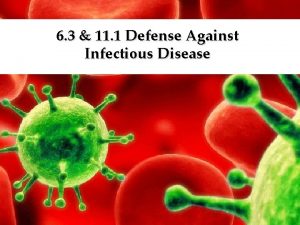Defense against Infectious Disease CH 10 Defense against
























- Slides: 24

Defense against Infectious Disease CH. 10

Defense against Pathogens God has wonderfully equipped the human body to resist disease Our body’s system of defenses is a solid testimony against evolution Defenses could not have developed over long periods of time; we would all be dead God has also given man resources and an innovative mind to develop medicines and therapy to overcome pathogens

Foreign Invaders Called Pathogens Viruses, bacteria or other living things that cause disease/immune response. Antigens Toxins that pathogens produce that cause harm to an organism.

3 Types of Defense Structural Defenses Nonspecific Defenses Specific Defenses

Structural Defense First Line of Defense The Skin • Provides Physical and Chemical barriers Physical – tough dead cells, made of indigestible keratin, and other layers of tightly packed cells Chemical – tears sweat mucous linings Stomach acid

Structural Defenses Natural “Flora” These are bacteria that live in our intestines and benefit us by breaking down some of our food and providing nutrients These non-pathogenic organisms occupy the areas in our GI tract that pathogens would like to occupy if they could However, certain antibiotics could destroy this natural flora and leave the intestines vulnerable to pathogenic invasion

Second Line of Defense – Nonspecific Immune Response Should a pathogen get past the skin… These are defenses the body uses no matter what the invader may be. These defenses include: Inflammation - caused by release of Histamine from leukocytes Fever The fever (high temp) kills invaders by inhibiting their growth. Boosts chemical reactions that are needed to activate the 3 rd line of defense Swelling – caused by fluid moving into damaged area Fever and swelling can also cause – redness to occur Phagocytosis – done by Macrophages* *Macrophage: A phagocytic cell found in the liver, spleen, brain and lungs. Travels to all areas of the body to find and eat pathogens.


Third Line of Defense Specific Immune Response If pathogens make it past the first 2 lines of defense then… A specific response to a pathogen/antigen has begun by the IMMUNE SYSTEM The system in the body responsible for maintaining homeostasis by recognizing harmful from non-harmful organisms and produces an appropriate response.

Parts of the Immune System 1. 2. 3. 4. Blood - White Blood Cells in particular. Lymph nodes Thymus Gland – Produces T Lymphocytes Bone Marrow – Produces B Lymphocytes

Immune Response The immune system has 2 main components: Chemicals called antibodies Several kinds of special cells, cells each with a specific job Antibodies are small “Y” shaped chemicals that circulate the body and attach to different pathogens and antigens

The Pathway of Specific Immune Response Step 1 Pathogens eaten by Macrophage Step 2 Displays portion of Pathogen on surface Step 3 Pathogens Helper-T cell recognizes Pathogen

What is Immunity?

Immunity The ability of the body to fight infection and/or foreign invaders by producing antibodies or killing infected cells. After defeating a certain pathogen/infection, cells in the immune system develop a “chemical memory” so that if that pathogen ever invades again, the immune response will begin almost immediately

Primary. vs. Secondary Immune Response

Autoimmune Disease Autoimmune diseases are diseases where the immune system begins to attack itself. Ex: Rheumatoid Arthritis – crippling disease of the joints. Lupus – disease of blood and organs. Multiple Sclerosis – disease of nervous system Cause(s): unknown Cures/Treatments: No known cures. Usually treated with drugs.

Medical Control of Disease Sometimes, despite the awesomeness of our body’s defense, physicians may prescribe various chemicals to help Chemotherapy – the use of chemical agents to treat or prevent disease Antibiotics Antiviral drugs Antihistamines vaccines

Antibiotics (“against – life”) – are chemicals designed to either destroy or disrupt the metabolic pathways of bacteria or other living pathogens Bactericidal (killing bacteria) Bacteriostatic (inhibiting the growth of bacteria) Antibiotics were discovered by accident by an English bacteriologist named Sir Alexander Fleming in 1929 He came back to his lab from vacation and notice a mold growing in the middle of a petri dish culture and a ring around the mold were no bacteria grew He called the chemical produced by the Penicillium mold penicillin

Antibiotics Common antibiotics: Penicillin and cephalosporin – inhibit synthesis of cell wall components Erythromycin and tetracycline – interfere with protein synthesis Rifampin – inhibits RNA synthesis Unfortunately, antibiotics are often not very specific in which bacteria they kill These are called broad-spectrum antibiotics

Antibiotic Resistance After penicillin was discovered, physicians started using antibiotics as a “cure-all” for any and every type of infection For a time, it worked Unfortunately, once the populations of pathogens killed by antibiotics, the pathogens that were naturally resistance began to thrive Now, scientists work to create antibiotics that are more specific to certain pathogens are more careful to regulate dosages and strength

Allergies Allergy - An exaggerated response by the immune system to an allergen. Allergen: a normally harmless substance that causes an allergic reaction. ex: dust, pollen, mold, food, insect stings Types of Allergic reactions There are two types of allergic reactions. a. Immediate – occurs within seconds and normally lasts for about 30 minutes b. Delayed – takes longer to react and can last for a much longer time

What happens during an allergic reaction? During an allergic reaction antibodies cause histamines to be released from certain cells. Histamines cause: a. Swelling of tissues b. Release of fluids (runny noses and eyes) c. muscle spasms (some cases) Anaphylaxis or anaphylactic shock: This is the sudden and severe allergic reaction to a substance that can cause death. Treatments for Allergies 1. Avoidance of material – especially food. 2. Epinephrine – “epi – pen” 3. Antihistamines -- benadryl

What causes allergies? ? ? “Hygiene Hypothesis” Developed countries like the US and Europe have more people who suffer from allergies than life-threatening diseases like parasitic worm infections, smallpox, viral outbreaks This hypothesis says that with improvements in sanitation, health care, and hygiene, we are reducing or even eliminating our exposure to many microbes and parasites immune systems are responding to SOMETHING (allergens) in order to keep itself ready

This powerpoint was kindly donated to www. worldofteaching. com http: //www. worldofteaching. com is home to over a thousand powerpoints submitted by teachers. This is a completely free site and requires no registration. Please visit and I hope it will help in your teaching.
 Smallest infectious agents
Smallest infectious agents Infectious disease quality controls
Infectious disease quality controls Stridor
Stridor Types of infection
Types of infection Infectious disease
Infectious disease Chapter 26 infectious disease prevention and control
Chapter 26 infectious disease prevention and control Hennepin county infectious disease manual
Hennepin county infectious disease manual Stages of infectious disease
Stages of infectious disease Communicable disease and non communicable disease
Communicable disease and non communicable disease Specific defense vs nonspecific defense
Specific defense vs nonspecific defense Lesson 27 using diet to guard against disease
Lesson 27 using diet to guard against disease Runtime defense hijacking attack
Runtime defense hijacking attack Infectious canine hepatitis in dogs
Infectious canine hepatitis in dogs Icd 10 morbus hansen
Icd 10 morbus hansen Emerging infectious diseases
Emerging infectious diseases Infectious nucleic acid
Infectious nucleic acid Whmis symbols skeleton hand
Whmis symbols skeleton hand Translation of infectious waste in tagalog
Translation of infectious waste in tagalog Infectious mononucleosis
Infectious mononucleosis Noncellular infectious protein particles are called
Noncellular infectious protein particles are called Infectious canine hepatitis in dogs
Infectious canine hepatitis in dogs Ebv
Ebv Infectious stunting syndrome
Infectious stunting syndrome Morbus kawasaki
Morbus kawasaki Christmas disease
Christmas disease


